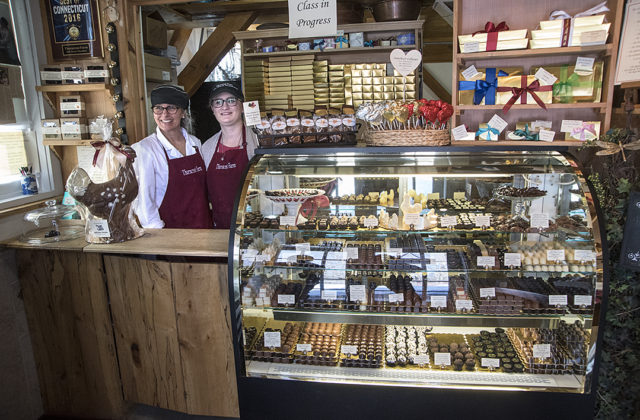Thorncrest Farm Magically Turns Milk into Chocolates
By Chris Sinclair
When rare ability is married with a singular passion, the results can transcend the exceptional and wander into the realm of magic. Such a marriage is on vivid display at Thorncrest Farm, in Goshen, where Clint and Kim Thorn, along with their crew and beloved “girls,” make some of the finest chocolates you can find—anywhere.
Walking into the main barn at Thorncrest, one is first struck by the size of the animals housed there. The cows, the foundation of the entire operation, are behemoths, some weighing in excess of a ton. Clint, Kim’s husband and the primary caretaker for the cows, is immensely knowledgeable about genetics and animal husbandry. He explains that he can trace the genealogy of some of his cows back several generations and says his cows more closely resemble cows one might have encountered in the mid-19th century but that are not at all common today. Clint adds that although breeding for certain physical characteristics is rather straightforward, breeding for flavor is notoriously tricky. In the Thorns’ herd, specific cows are milked for specific flavors. For example, there are dark chocolate cows, a milk chocolate group, and even a lone cow named Daydream who is famous for her caramels. Clint says that some cows produce completely different flavors from their mothers, and that the “flavor gene” is recessive and unpredictable, even for someone with his expertise.
While Clint and Kim’s cows possess an uncommon genetic makeup and naturally produce certain nuanced flavors, the qualities of their milk can be further manipulated by careful attention to countless variables related to their care and lifestyle. All of the cows’ feed is grown on-site, and different cows receive different diets at different times. Clint casually picks up a bale of hay, pulling out virtually identical strands and leaves, describing their differences and the way some cows prefer one to another depending upon the day. Barn swallows dart and dive overhead, flitting between their nests in the low rafters. The cows enjoy having the birds around not only for their presence but also for their voracious fly diet when the warmer seasons come. The waterlines that lead to each cows’ water bowl are infused with a shot of air, the sound of which mimics the whoosh and babble of a springtime stream. The cows are dry brushed twice daily but never washed with any soap, lest the soap be absorbed into the skin and find its way into the milk, which Clint says that it inevitably would. Clint does not allow certain lights in the barn, per the cows’ preference.
When the cows are out of the barn Clint watches them carefully, noticing which cows seem to get along and which don’t, and he houses them in the barn accordingly. Clint recalls a night when one cow, moved from her usual spot in the barn, spent the night alongside a cow who, as Clint came to deduce, she did not particularly care for. The following day when this cow was milked, Kim deemed the milk to be no good, as the stress experienced by the cow overnight had sufficiently tainted the milk so as to render it unusable, by the lights of her extraordinary palate.
Clint characterizes his wife’s assessments of various dairy products as instantaneous and nearly infallible. She need only pass her face over the top of a bucket of milk or take one small taste to know if it’s suited to the delicious and alchemical pursuit of the moment. The nuance at work is imperceptible to any ordinary person. Taking this a step further, Clint claims that his wife can smell an area on the cow around the upper rear leg and determine by the scent alone a host of characteristics that the milk produced by that cow will likely possess. Kim has no desire to doctor up her milk or to add outside flavors. Rather, she and Clint attempt to bring out the full depth and scope of the flavors that the cows naturally produce. It is this palate that takes Kim in directions that other chocolatiers would not dare explore. Among the chocolates currently on the menu are a Dark Chocolate Madras Curry, Dark Chocolate Lavender and Karissma’s (one of their cows) Cabernet Sauvignon Truffle, to name only a few.
Thorncrest’s motto, fittingly, is “The Magic Is in Our Milk.” As I was handed a small bowl of freshly made ricotta cheese—subtle, rich and unlike any cheese one can find elsewhere—Clint pointed out that everything in my bowl had been grass just yesterday. The magic was abundantly clear.
Thorncrest Farm & Milk House Chocolates is open Wednesday to Saturday, 10 to 5, and Sunday, 10 to 4. The barn is usually open 10 to 3, Thursday through Sunday. You can also order from their website, milkhousechocolates.net, which is now featuring a full array of Easter chocolates.


I know now that if I still lived in CT I’d be there in a flash ~ I had no idea but this descriptive, animated review of the establishment left me hoping they ship their chocolates! Wow, well done Chris. And if I get back up that way it will be on my bucket list. Thanks for a wonderful article.